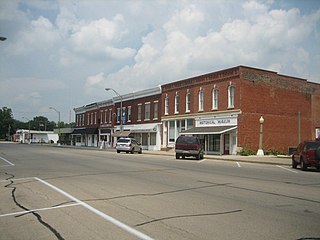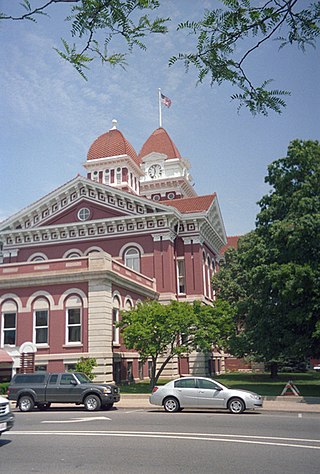
The South Omaha Main Street Historic District is located along South 24th Street between M and O Streets in South Omaha, Nebraska. It was added to the National Register of Historic Places in 1989. Home to dozens of historically important buildings, including the Packer's National Bank Building, the historic district includes 129 acres (0.52 km2) and more than 32 buildings.

The Main Street Historic District in Tampico, Illinois, United States is a historic district notable as home to the birthplace of Ronald Reagan. The district includes the late 19th century collection of buildings that comprise Tampico's central business district, among them are two apartments that the Reagan family occupied in the early 1900s. The buildings in the district went through several periods of rebuilding during the 1870s due to major fires and a tornado. The district boundaries encompass the 100 block of Main Street and exclude properties that do not date from the historic period.

The Broadway Historic District is located along Broadway in Saratoga Springs, New York, United States. It has a twofold character. The southern section is the commercial core of the city, with many of its important public and private buildings, most intact from its peak days as a resort town in that era. North Broadway is a residential neighborhood with many large Victorian houses built by frequent visitors to the town and its spas and racetrack.

The Downtown Albany Historic District is a 19-block, 66.6-acre (27.0 ha) area of Albany, New York, United States, centered on the junction of State and North and South Pearl streets. It is the oldest settled area of the city, originally planned and settled in the 17th century, and the nucleus of its later development and expansion. In 1980 it was designated a historic district by the city and then listed on the National Register of Historic Places.

Tifton Commercial Historic District, in Tifton in Tift County, Georgia, is a historic district that was listed on the National Register of Historic Places (NRHP) in 1986 and expanded in 1994. The original listing was portions of 10 blocks including buildings from the 1890s to the late 1930s, most built of brick.

Crown Point Courthouse Square Historic District is a historic district in Crown Point, Indiana, that dates back to 1873. It was listed on the National Register of Historic Places in 2004. Its boundaries were changed in 2005, and it was increased in 2007 to include a Moderne architecture building at 208 Main Street. The late nineteenth- and early twentieth-century commercial and public buildings represent a period of economic and political growth. The Lake County Courthouse stands in the center of the district. Designed by architect John C. Cochrane in 1878, this brick building is a combination of Romanesque Revival and Classical styles. Enlarged in 1909 with the addition of north and south wings, designed by Beers and Beers. Continued growth in the county required second enlargement in 1928. This local landmark was placed in the National Register of Historic Places in 1973.

West Haven Green is the town green of the New England town of West Haven, Connecticut. The green is bordered by Church Street on the south, Savin Avenue on the west, Main Street on the north and Campbell Avenue on the east. The green and surrounding buildings are part of the West Haven Green Historic District.

The North Main–Bank Streets Historic District is located along those streets in Albion, New York, United States. It is one of two historic districts in the village, comprising the commercial core of the village, developed during its years as a major stop on the Erie Canal. A portion of the canal, now the New York State Barge Canal, and two of its bridges are within the district.

The Broadway–Livingston Avenue Historic District is located at the junction of those two streets in Albany, New York, United States. It includes seven buildings remaining from an original 20, all contributing properties, and a Warren truss railroad bridge. In 1988 the area was recognized as a historic district and listed on the National Register of Historic Places.

Welch Commercial Historic District is a national historic district located at Welch, McDowell County, West Virginia. The district includes 56 contributing buildings and one contributing structure in Welch's central business district. It includes a variety of retail stores, banks and offices, with some having apartment rental on their top floors. Also on the district is a municipal parking garage built in 1941. Notable buildings include The Liberty Building, the Flat Iron Building, Bablis Building, former City Hall, Odd Fellows Temple (1929), Carter Hotel-Tyson Tower Building (1924), Wyoming-Elkhorn Apartment Building, McDowell County National Bank (1900), and McDowell County Courthouse Annex Building (1935).
The Monticello Commercial Historic District encompasses a portion of the historic business district of Monticello, the seat of Drew County, Arkansas. The district was listed on the National Register of Historic Places in 2011.

The Helper Historic District is a historic district comprising the center of Helper, Utah. When originally listed on the National Register of Historic Places in 1979, the district was called the Helper Commercial District. It was bounded by Janet Street to the north and Locust Street to the south, and by First West Street to the west and the Denver and Rio Grande Western Railroad (D&RGW) yards to the east. It comprised 110 buildings, 98 of which are considered contributing structures. Typical buildings are one to two stories tall in a variety of styles, mostly built in red brick. The district included a number of modest one-story residences, built by the railroad and mining companies in the manner of a company town. The district represented Helper's development as the commercial center of the local coal-mining industry, and as a railroad service center.

The 100 Block of West Broadway Historic District is a nationally recognized historic district located in Council Bluffs, Iowa, United States. It was listed on the National Register of Historic Places in 2002. At the time of its nomination the district consisted of 30 resources, including 22 contributing buildings, and eight non-contributing buildings. The linear district on the east side of the central business district is the north side of Broadway. Developed between mid-1850s and 1928, it is the only section of the street that has maintained its historical integrity. The buildings are one to three stories tall with commercial space on the main floor. While many are vernacular commercial structures, others are the various revival styles of Victorian architecture.

The Railroad Street Historic District encompasses a cluster of commercial and railroad-related buildings at the traditional late 19th-century heart of St. Johnsbury, Vermont. It includes five commercial buildings and the town's 1883 union depot, and is reflective of the town's importance as a major railroad junction in northern New England. The district was listed on the National Register of Historic Places in 1974. It was subsumed by the larger St. Johnsbury Historic District in 1980.

Old Main Street Historic District is a nationally recognized historic district located in Dubuque, Iowa, United States. It was listed on the National Register of Historic Places in 1983. At the time of its nomination it consisted of 33 resources, which included 30 contributing buildings and three non-contributing buildings. In 2015 the boundaries were increased to include five more buildings. Four of the buildings are contributing properties that were excluded from the original district because they were slated to be torn down as a part of the expansion of U.S. Route 61. While the highway was built the buildings were spared. The fifth building is non-contributing as are three structures.

The North Main Street Commercial Historic District in Statesboro, Georgia is a historic district that was listed on the National Register of Historic Places in 1989. It includes eight adjacent contributing buildings on the west side of the first block of North Main Street. It does not include the property at the corner of West Main and North Main, but rather is the next eight buildings going north from that, to and including the corner of Courtland Street.

The Island Historic District is a mixed commercial and residential historic district located in Plainwell, Michigan. It is roughly bounded by Bannister Street to the north, Hill Street to the south, the Kalamazoo River to the east, and Park Street to the west, as well as including properties along Main Street south of the mill race and along Bridge Street west to the mill race. The district was listed on the National Register of Historic Places in 1991.

The Jackson Commercial District in Jackson, Kentucky is a 2.8 acres (1.1 ha) historic district which was listed on the National Register of Historic Places in 1986. The listing included 13 contributing buildings, two non-contributing buildings and two non-contributing sites.

The Scottsville Downtown Commercial Historic District, in Scottsville, Kentucky is a 14 acres (5.7 ha) historic district which was listed on the National Register of Historic Places in 2001.

Alexander City Commercial Historic District, in Alexander City, Alabama, is a historic district which was listed on the National Register of Historic Places in 2000. The listing includes 32 contributing buildings and a contributing site on 8 acres (3.2 ha).





















